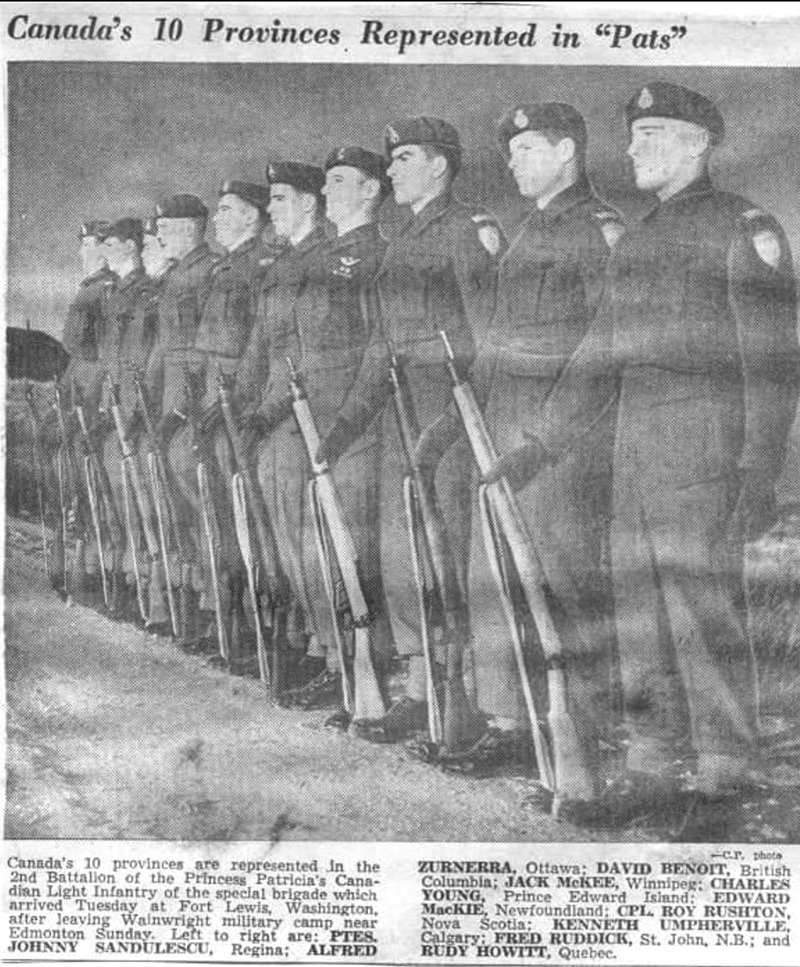 |
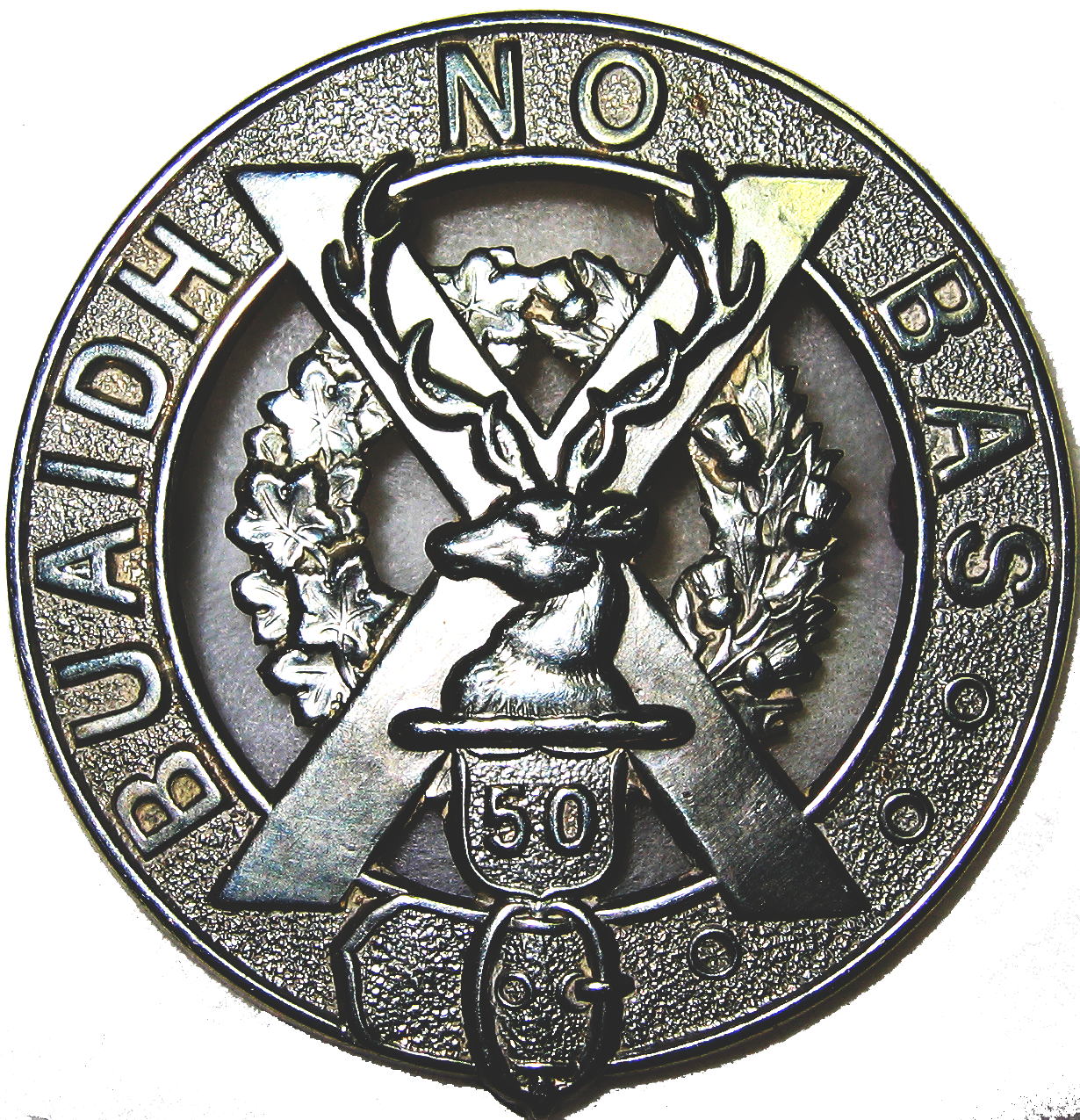 OPCMHVisitor No.: |
HISTORY OF WORK POINT BARRACKSby Jack BatesPART 6 — 1940 to 19561946Royal Canadian School of Artillery (Coast and Anti Aircraft) was established at Work Point Barracks, and 119 HAA Battery was also located there. OPCMH An article in the BC Historical Quarterly Vol. X No. 3 July 1946 was written by Madge Wolfenden on Esquimalt Dockyard’s First Buildings. These were known as the “Crimea Huts.” Madge was the daughter of Cpl. become Lieutenant-Colonel Richard Wolfenden, from the Royal Engineers to the 5th Regiment in Victoria, and she wrote a number of articles of historical interest. Here is the article: ESQUIMALT DOCKYARD'S FIRST BUILDINGS The three frame structures built during the Crimean War at Duntze Head, on Esquimalt Harbour, by Governor Douglas in answer to Admiral Bruce's request for temporary hospital accommodation for his squadron, have, for many years, been a source of much interest to students and others. The following notes and photographs have been gathered together recently, and are now presented in completion of the story of the "Crimean huts," as they have been popularly designated. From time to time in the pages of this Quarterly, and elsewhere, reference has been made to their raison d'etre, their structure, their uses, and their final disposal1 but, for the sake of clarity, it has been thought helpful to reiterate briefly the story of their building and the changes through which they passed. Upon receiving Admiral Bruce's instructions on May 7, 1855, Douglas lost no time in causing the hospital buildings to be commenced, thereby taking the first step towards the establishment of a naval base, which he had been advocating for the previous two years. By June 13 he was able to report to the Home Government: "... I was induced ... to commence the erection of airy and roomy buildings in a healthy and convenient locality ... the buildings will be habitable by the end of this month..."2 Four months later, by which time they had been completed, he described them as follows: The hospital consists of three buildings, a centre and two wings, each 50 feet long by 30 feet wide, and 12 feet from floor to ceiling. The windows are large and the ventilation perfect. The centre building contains a Kitchen, operating room, dispensary, and Surgeon's apartments; the wings contain the sick wards and will accommodate 100 patients. . . .3 In the same communication Douglas mentions the fact that the hospital was "well adapted for the purpose intended and otherwise a valuable property which . . . may be sold, at any time for the full sum it has cost." Admiral Bruce, who had only a very temporary building or rented premises in mind when he first wrote to Douglas, was disturbed to find that the hospital had cost nearly £1,000, and expressed the opinion that this was considerably more than the British Government would be willing to pay. Douglas had foreseen that a dispute over costs would arise, and presented his case with such logic and firmness that the Admiralty finally paid up in 1857. The same year he handed the buildings over to Captain Prevost, of H.M.S. Satellite, who took charge of them in the Admiralty's name. But although they thus became possessed of buildings there, it was not until June 29, 1865, that the Shore Establishment of Esquimalt was formally authorized by the Admiralty. In the meantime the buildings had been put to good use, one becoming a storeroom, whilst the second remained a hospital. Towards the end of 1858 part of the third building was adapted as a draughting-room for the use of the officers of H.M. surveying ship Plumper, and in 1859 Assistant-Surgeon Samuel Campbell, who was in charge of the hospital, made his residence there. In order to avoid repetition, and with the object of communicating all that is known about these historic buildings, the details of their service have been listed in an appendix. Two of them, as is well known, survived until 1936 and 1939 respectively. The fate of the third building after the group ceased to be used as a hospital remained a mystery until recently, when the following letter furnished the clue that enabled the writer to solve the riddle. New W[estminste]r. 10 Novr. 18634 Sir, I have the honor to 'forward herewith Plan & Elevation for converting one of the vacant Log Buildings at the Old Hospital Point Esquimalt into a moderate [modern?] residence 'for Admiral Commanding on this Station. You will observe it consists of removing a few partitions, altering Windows & Doors, and adding a new portion at the end. It also provides a Kitchen, Store room, &c. I have also thought it as well to design an upper Storey for further extension of accommodation some future day. Mr. White5 lately discharged from the R[oyal] E[ngineers] the very intelligent N.C.O. who waited on you is now establishing himself as a Builder & Architect. He designed these adaptations and would be a suitable person to undertake the construction. I have, &c., Rear Admiral J Kingcome
Comdr.-in-Chief The next step in unravelling the history of building No.3 was to discover whether Colonel Moody's suggestion was ever carried out, and, if possible, when the alterations were made. In an album of photographs taken by Frederick Dally between the years 1867 and 1870 is one showing these three buildings side by side; the most southerly building of the three is in the process of conversion to a dwelling-house with a second story. Another photograph a1bum, kept by Commander H. W. Mist whilst in command of H.M.S. Sparrowhawk on the Esquimalt Station from 1868 to 1872, shows the dwelling complete, with dormer windows in the roof. The evidence of these photographs, dated as they are with fair precision, would seem to indicate that although Colonel Moody's letter was written in the autumn of 1863, the alterations to the building were not effected until 1867 at the earliest. His second suggestion, namely, that building No.3 should become a residence for the Admiral, was apparently never acted upon, or we know that Admiral Hastings, who was in command of the Esquimalt Station from 1867 until 1869, lived at "Maplebank," a house built on Hudson's Bay Company property near the Indian Reserve on the opposite side of the harbour. It is also fairly certain that Admiral Denman also lived at "Maplebank" even previous to that time, when it was known as "Dallas Bank." The first naval storekeeper to be appointed to Esquimalt was Paymaster Sidney John Spark, R.N., who took over his duties at the Dockyard late in 1865. Research has not revealed whether he used the residence in question, but it is surmised that during the latter part of his appointment he did so. Paymaster Spark was succeeded in 1873 by James Henry Innes. Mr. Innes, who, with his wife and seven children travelled from England to Victoria, found upon arrival that the house in which he was expected to live was not sufficiently commodious for his numerous family.6 Mrs. W. E. Scott, of Ganges Harbour, Saltspring Island, who is the only surviving member of the Innes family in British Columbia, has been most helpful in identifying her father's house and office in the photographs, and in relating interesting details concerning her childhood days spent at Duntze Head. Mrs. Scott relates that the family boarded with Mrs. H. B. Ella, on Fort Street, while more and necessary alterations were made to their house. The Innes family lived in the converted "Crimean" building until 1885, when plans for a bigger and more suitable house for the Storekeeper were put into execution. These plans resulted in the building of the brick house7 adjoining the site of the three original huts, with its front door facing north instead of west. To obtain the necessary space for the brick house it was expedient to demolish the former dwelling-house, consequently the Storekeeper and his family were obliged to find other quarters in the intervaL They occupied the house lately vacated by the Dockyard Engineer, the most northerly one of the group as shown in the accompanying photographs, and designated building No. 1. Owing to the fact that the correspondence between the naval authorities at Esquimalt and the Home Government was removed at the time of the withdrawal of the Imperial forces from this coast, many interesting facts concerning the Dockyard and its development by necessity remain obscure. The photographs and the documents to which reference has been are are all to be found in the Provincial Archives.
— Madge Wolfenden Footnotes/References:
APPENDIX* Building No. 1 This building was first used as a store and provision room for the hospital from 1856 until 1859, when it became a hospital ward. From 1862, when the hospital was transferred to Skinner Cove, it apparently was vacant. Presumably from 1871 until 1879, when another residence was built, it was used by the Chief Engineer of the Dockyard. After 1885 and until 1910 it served as a double residence for the Chief Boatswain and Carpenter of the dockyard; in 1891 it was added to. From 1910 and until 1914 the Chief Clerk of the Naval Stores Officer lived in part of it, the other part remaining vacant. During World War I the building became the office of H.M.C.S. Shearwater Shore Establishment. The rear section, originally kitchens, was condemned in 1917 and torn down. The main portion of the building stood empty after the conclusion of hostilities and until 1936, when it was demolished.
Building No. 2 From 1856 until 1862 this was the Naval Hospital proper. In 1865, when Paymaster S. J. Spark was appointed Paymaster-in-Charge of Victualling Stores, it became his office and continued as the office of the Naval Storekeeper until the withdrawal of the Imperial forces in 1905. Quarters were also provided in it for the Commander-in-Chief Pacific Coast, when ashore. Alterations were effected in 1901. From 1905 onwards it was the office of the Naval Agent, and later of the Superintendent of the Dockyard. In 1913 it was in use as the general office of the Dockyard Civilian staff, and during World War I it was enlarged to accommodate a larger staff. Though condemned in 1936 because of the ravages of dry-rot, it was not finally demolished until 1939. Building No. 3 This building seems to have remained unused until 1858, when it was converted into a drawing office for the use of the officers of H.M.S. Plumper. Upon Doctor Campbell's appointment to the hospital, half of it was used by him as a residence. Between 1867 and 1870 it was converted into a twostory dwelling-house for the Naval Storekeeper. Altered in 1873 to accommodate the large family of Mr. J. H. Innes, it was demolished in 1885, to make room for the brick dwelling now designated " Dockyard House." ______
Daily Colonist Macaulay Point Camp Huts Now Released for Housing Release of army huts at Macaulay Point Camp by the Department of National Defence for housing purposes was reported yesterday to Mayor Percy E. George by J. G. Walker, emergency shelter administrator. Mr. Walker said he is having the necessary documents prepared for signature. This procedure is being done through offices of Military District No. 11. It was also reported that clearance for the immediate use of Colwood camp was anticipated. Alderman R.A.C. Dewar, chairman of the city housing committee, will look into the Macaulay camp business when he returns from Harrison Hot Springs. It is not known how many families can be accommodated at the camp facilities, or what conversion work will be necessary. COLONIST WAR VETERANS’ ALLOWANCE ACT IS CLARIFIED BY LEGION COUNCIL Desirous that veterans and widows who qualify for War Veterans’ Allowance, shall have their rights, Victoria District Council of the Canadian Legion, has had the Act clarified by the Dominion Command. Here are the allowances under the Act, in effect since August 1 of this year, as contained in a statement issued by the Canadian Legion:
The Canadian Legion points out that the extra allowance permitted during the period of the World War, where the recipient had no fixed income, from other sources. Victoria Times 48 Suites To Be Built At Macaulay For War Veterans Three huts taken over at Macaulay Point army camp to provide housing accommodation for war veterans and their families will be divided into 48 suites of three rooms each, A. Palmer, executive secretary of the Citizen’s Rehabilitation Council, said today. Conversion of the huts probably will start at the beginning of November, and because of the labor and material situation, the work will take about three months, Mr. Palmer said. The conversion of the three large huts will cost approximately $10,000, it is estimated, of which Canadian Mortgage and Housing Corporation is to bear half. Each of the huts will contain 19 suites, the rooms in each suite measuring approximately 10 by 10 feet. The huts will be converted one by one, rather than all together, Mr. Palmer said. Daily Colonist Children’s Party Held by P.P.C.L.I. Children of personnel of P.P.C.L.I. Regiment were entertained at a successful Christmas party yesterday afternoon at the Y.M.C.A. hut, Camp Macaulay. Ex Sergeant Major R. McVie, P.P.C.L.I., in the role of Santa Claus, distributed gifts to each child together with chocolate bars, nuts and oranges. Refreshments were served, with ice cream for the children, and tea was poured by Mrs. G.R. Pearkes, Mrs. J.G. Harper, Mrs. R.L. Mitchell and Mrs. W.G. Colquhoun. During the afternoon several moving pictures were shown by Sgt. Earl. Among the special guests were Major General G.R. Pearkes, V.C., D.S.O., M.P., Mrs. Pearkes and Master John Pearkes; Col. R.L. Mitchell and Mrs. Mitchell, Lieut. Col. Macgregor Macintosh, Brig. And Mrs. Colquhoun, Capt. and Mrs. C. Laurence and Capt. B. Mainprize. The affair was convened by Mrs. R. McVie with a committee consisting of Mrs. C. Pelly, Mrs. F. Mainprize, Mrs. S. Mitchell, Mrs. G. White, Mrs. Davies and Mrs. Siddens. Gifts were presented by Mrs. Colquhoun to Mrs. Pelly, president, Mrs. R. McVie, secretary and Mrs. Mainprize in recognition of their services from the officers and members of the W.A. to P.P.C.L.I. Victoria Times Gallant P.P.C.L.I. Veterans and Children Enjoy Christmas Enjoying their first Christmas party together in many years, the P.P.C.L.I. veterans, their wives and children met around a gaily decorated Christmas tree at the Y.M.C.A. yesterday. From the healthy cherubs sitting on the floor and the babies to tall young sons, all had a merry time. Guests of honor at the party were Brig. and Mrs. Gorley Colquhoun and Lieut. Col. Macgregor Macintosh. Of course Santa, who arrived with jingling bells and distributed gifts, was the most important person there. Mrs. Ross Palmer showed some interesting films to the youngsters, assisted by Cpl. West. Receiving with the convenor, Mrs. C.F. Laurence, was the president Mrs. A.C. Pelly.
I am there in the front row! 1947
CANADIAN ARMY The Canadian Army 1947
Township of Esquimalt The Reeve stated he had received permission from Colonel Perrin to permit the Public to use the Pool built by the Army at Macaulay Camp at Kinver Beach. The public would not be permitted access through the Military Property. The pool would be cleaned out and the services of the Army Engineer in this matter had been offered. Moved by Councillor Christensen, seconded by Councillor Bishop: that “A letter of thanks be written to Colonel Perrin for granting use of the Pool at Macaulay Camp.” Carried.
Victoria Times TIME GUN TO BOOM IN VICTORIA AGAIN The pre war custom of firing a time gun twice daily from Work Point Barracks will be revived Monday. The custom originated at the turn of the century when masters of British ships, stationed here, would synchronize their chronometers by the firing of a gun from the flagship, H.M.S. Grafton. In 1906 the custom of firing the noon gun was taken over by the army garrison. The army also fired the gun at 9 in the evening as the first post. The last post was sounded by a bugler. This practice was continued until 1940 when wartime regulations caused it to be stopped. Until then Victorian used the sound of the gun to check their watches and clocks. Commencing Monday, the gun will be fired at noon and at 9 in the evening by members of the West Coast Artillery, R.C.A. at Work Point Barracks on direct phone contact with the Meteorological Observatory on Gonzales Hill. Daily Colonist Work Point Guns Familiar Before War Familiar booming of the daily time guns at Work Point Barracks, so popular with Victorians before firing of the guns was stopped shortly after the outbreak of war, again will be heard throughout this area beginning tomorrow, according to announcement from Lieut. Col. A.C. Perron, officer commanding Coast Artillery, West Coast, R.C.A. Col. Perron said the guns will be fored daily at noon and 9 p.m., as they were before the war, on time signals provided by the Mateorological Observatory on Gonzales Hill. Originated around 1900, when masters of British ships stationed here synchronized their chronometers with the firing of a gun from the flagship H.M.S. Grafton, the custom was taken over by the army garrison in 1906, and continued until 1940 when it was suspended by wartime regulations. January 7, 1947 Work Point Time Gun Again Tells Time Remember the “noon gun” blasts of prewar days? They were resumed yesterday, and will continue daily for an indefinite time. Another daily time signal will be fired each night at 9 o’clock. Seconds before yesterday’s noon blast, the above photograph was taken at Work Point Barracks, location of the field gun from which 25 pound blanks are fired. Getting an exact time order from the Gonzales Observatory is Bombardier W. Lessard, 519 Gore Street. The barrel of the gun points directly over West Bay toward the Empress Hotel. The time signals were discontinued early in 1940, and have been missed since that time by many Victorians who depend on them for setting watches and clocks. The old gun used before the war – one that fired 12 pound blanks – has been scrapped.
Bdr. Lessard was the same “Frenchie” who opened the little confectionery store at that address shortly after. The hangout for “us local kids.” TIMES
March 5, 1947 Work Point Soldiers Get Wardrobes in Barracks Recent renovations at Work Point Barracks, in keeping with the streamlining of the Canadian Army, stress privacy and comfort of the ordinary soldier.Left picture clothing was hung on peg over bed, shoes piled underneath and kit on shelf. To the right is a new wardrobe, designed by a Work Point soldier, now in extensive use throughout. A man’s uniform is stored with his civilian clothes, while drawers provide ample space for all personal belongings. Recently Major-Gen- commanding western Army Command, ordered a blue print of the new wardrobe, and said if it proves satisfactory it would be adopted for use in Army quarters across Canada. Changes at Work Point Stress Soldier’s Privacy Old Amy Barrack Room System The modern Canadian soldier today has some of the advantages of a civilian when it comes to living quarters. Recent innovations at Work Point Barracks show the vast difference since recent changes were made. Top picture shows a typical wartime barracks with beds grouped in a single room, clothes hanging from hooks and shoes under bed. Bottom piture shows new quarters after the barracks were remodelled. Here the soldier has a reading lamp, table for books and radio and shelf. Cupboard at right holds all his uniforms and civilian clothing rifle and kit, and windows have curtains made by army tailor. Floor is green linoleum, and semi-private rooms are done in two colours. Each barracks has a living-room with radio and easy chairs. Photos compliments of The Colonist.
Township of Esquimalt Minute Book Regarding the Plaque for the Memorial in the Park, the Reeve stated the I.O.D.E suggested the probability of using the same plaque and including dates of the last war also. The Reeve stated he had received permission from Colonel Perrin to permit the public to use the pool built by the Army at Macaulay Camp at Kinver Beach. The public would not be permitted access through the military property. The pool would be cleaned out and the services of the army Engineer in this matter had been offered. Moved by Councillor Christensen, seconded by Councillor Bishop, that: “A letter of thanks be written to Colonel Perrin for granting use of pool at Macaulay Camp.” September 30, 1947 Royal Canadian Corps of Signals RECRUITS WANTED 50 Boys, Age 14 – 18 - Height 5 Feet or Over TRAINING: FRIDAYS – 7:30 – 9:30 P.M. Uniform (Battle Dress, Beret, Shirt and Tie, Web) Issued Immediately on Enlistment. Applicants Apply to Room 107, Hospital Building, Work Point Barracks, Report to Capt. J.T. Ross or Phone B 4320 Any Day After 5 P.M. Esquimalt Archives Article “Ashburn”, the classic home of the renowned military Peters family at 423 Peters street, was demolished in 1947 and the old wooden fence taken down. Daily Colonist Say Vandalism, Deterioration Cut Value of War Asset Huts Because of vandalism and deterioration of 27 huts at Macaulay, McLaughlin Point and Peters Street, Reeve A. I. Thomas said yesterday the price asked for by War Assets Corporation “is not acceptable to Esquimalt Municipality.” The huts were offered to the municipality at a cost of $14,638. The sum is 8 percent of the original cost, plus 10 percent restoration charges, which would bring the total cost to the requested figure. Reeve Thomas maintains it is now up to the War Assets Corporation to send a representative to further investigate the buildings in their present condition. He said it is felt if suitable adjustments can be made in the price negotiations will be opened. Veterans would be able to secure lumber from the buildings. Major Carl Fallas, chairman of the Zone Council of the Canadian Legion, said the huts were in “deplorable condition” and that the price should be lowered to a point where it will pay veterans to salvage the lumber and use it in construction of their own permanent homes. War Assets Corporation The private residence at 984 Vaughn street expropriated in 1942 has been declared surplus and will be demolished. It served as Bldg. # 1 – Gunner’s Quarters for the Harrison Point 13 LAA Battery. The building was build prior to 1912, estimated at 1903-1904, and has been vacant since 1945. A 1944 drawing shows other civilian houses: # 981 Vaughn; 216, 217 and 219 Anson street for the 13 LAA Battery and the Anti-Aircraft location. Also five houses on Clent street for officers of the 27th Regiment, as well as the assumed location of the 60th Battery Searchlight and power house on the south east of Harrison Point. Shown as well is 316 Anson street used as CWAC Officers quarters. 1948COLONIST SONGHEES TRIBE MAY BE MOVED FOR RACE TRACK WOULD SETTLE ON NEW RESERVE NEGOTIATION RUMORS INDICATE The Songhees Indians, first owners of Victoria, may move their home for the second time within 40 years. Unofficial reports indicate that four-cornered negotiations now under way, involving the Municipality of Esquimalt, the B.C. Agricultural Association, the Songhees Tribe and the Dominion Government, may eventually give the Songhees a new reserve and establish a racetrack and fair grounds on the present reserve at Craigflower and Admirals Road. MACAULAY CAMP Click here to view the details of permits for the removal of the Army Huts from “Macaulay Camp,” south of Lyall Street, in the Township of Esquimalt from 1948 to 1952. Click to view aerial photo of McLoughlin Point in 1947. COLONIST “THE FIFTH” – AN HONORED REGIMENT Note – The late Lieut. Col. F. A. Robertson, during the period he commanded the Fifth Regiment, compiled a history of the unit, which is now a treasured possession of the Officer’s Mess. Typewritten, the record makes quite a substantial volume. Through the courtesy of Colonel Paulin and officers of the regiment, the writer was able to read its well-thumbed pages to prepare this necessarily brief story. Now known as the Fifth Heavy Anti-Aircraft Regiment, Victoria’s oldest military unit has had a number of appellations attached to it since it was established in 1878, when, as a result of amalgamating several units, the oldest of which dated from 1862, it was first known as the Victoria Battery of Garrison Artillery. In 1883 it became the Fifth (B.C. Regiment) Canadian Garrison Artillery; in 1886 it was gazette as the British Columbia Brigade of Garrison Artillery; in 1893 as the British Columbia Battalion of Garrison Artillery; and in 1896 it became the Fifth Regiment Canadian Artillery. During the years since it was organized as an artillery unit by Major C. T. Dupont and Captain David Garrick McNaughton, the Fifth has occupied a high place on the honor roll of Canadian military organizations. It has had a notable list of commanding officers, too – men who devoted the best traits of citizenship, unselfishly, to build up a militia organization which would be sufficient unto the need if the day ever chanced when Canada would require a fighting force for the adequate defence of the country, at home or abroad. As they stood ready to serve their land in peace and in war, the names of the Fifth’s commanding officers between 1878 and the present day included Major C. T. Dupont, Lieut. Colonels R. Wolfenden, E. G. Prior, F. B. Gregory, Ross Munro, J. A. Hall, Sir A. W. Currie, K.C.B., K.C.M.G., W. N. Winsby, R. Angus, J. C; Harris, F. A. Robertson, T. B. Monk, M. A. Kent, V. McKenna, M.C., and George Paulin, present officer commanding. In addition to its leaders, the Fifth has also consistently attracted the best type of citizen to wear the uniform of the rank and file and to serve as subalterns and non-commissioned ranks. High honors were early attained by its gunners on Canadian and Mother Country artillery ranges; while some of the finest rifle shots ever to level a service rifle at targets of the Bisley butts wore the uniform of the Fifth. During the piping times of peace the regiment became proficient in battle tactics, the serving of field guns, in the practice of musketry, and made many smart appearances on Beacon Hill and Macaulay Plains. The drill hall of the regiment was also the centre of social activities – dances and promenade concerts, with the regimental band supplying the music; while a general camaraderie was encouraged at all times. Guards of honor paraded when legislatures were convened and when the city was host to Canada’s Governor-Generals and members of the Royal Family. Sport was also factor in maintaining regimental morale, the regiment being frequently represented by winning teams, particularly on the cricket and football teams. Carrying out the sterner duties, there were times when the regiment was called out to protect life and property, like the several occasions when strikes threatened to upset the even tenor, of life on the island. Fortunately, owing largely to the level-headedness and good judgement of the men in charge on those occasions, nothing ever happened in the way of serious consequences. READY FOR SACRIFICES At all times, too the men of the Fifth Regiment have been ready and willing to make great sacrifices, if necessary, in order to maintain British principles and institutions, no matter where these chances to be threatened; and when drums beat in South Africa and the bugles in the British Isles echoed the call, all of the local artillerymen wanted to go with the contingent Canada offered in 1899. It was the same during the Great War, while since the Nazis set out to subjugate the world men from the Fifth have served in every theatre where men fought and died for the British brand of liberty. The stark years of hostilities, which came to an end officially in 1945, during which Canada’s militiamen carried on the traditions of the men who stormed Cronje’s Laager on the Modder River one memorable morning and fought a long series of fights across Flanders Fields later on counted a number of men belonging to the Fifth Regiment, which had always given of its best and incidentally made possible the services of Canada’s most noted soldier, Arthur Currie, who enrolled as a private in the ranks during the late nineties. ______________________ Oldest military unit of Western Canada, the Fifth Regiment, Heavy Anti-Aircraft Battery, R.C.A., really began its story in 1883, when three units, which had survived for some time, amalgamated. The units then brought together included the Victoria Battery, formed in 1878; the Seymour Battery of New Westminster, a volunteer company of Victoria Rifles, first organized as a volunteer unit in 1862. AUTHORIZED IN 1878 Really, as far as Victoria military activities along the years are concerned the forming of the Fifth Battery of Garrison Artillery in 1878 marks the beginning of the present regiment as an artillery unit. Its formation was authorized in a Militia Order dated July 19, 1878. Captain C. T. Dupont was its first captain, and David Garrick McNaughton, who was most active in the organization of the unit, was first lieutenant; while Arthur William Jones was second lieutenant. The authorized strength was three officers and fifty non-commissioned officers and men. Origin of this artillery company was really due to the Russo-Turkish War, declared in April 1877, when it was expected other European countries would become involved. Relations between Britain and Russia became strained when Russia occupied Adrianople; for the great fear was that further Russian successes would prove a menace to British Relations with India. Always ready to help in the defence of the motherland, Canada offered a force of several thousand men for service with the British Army; but their services were never required, although the preparations to furnish the volunteers was timely; for it so happened that Fenian agitators operating in the United States were planning to make raids into Canada should Britain become involved in war with Russia. SCARE FROM RUSSIA About this same time, according to an article in The Daily Colonist of February, 1878, a Russian squadron of five war vessels arrived on this coast and anchored in San Francisco Bay, causing some excitement locally, emphasized when Victoria banks hastily transferred their cash and securities to Port Angeles for safety. It was then that Colonel Houghton, D.A.G. for M.D. 11, requested Dupont and McNaughton to undertake the organization of the battery. During that same month another incident helped the battery to get away to a good start. Major Dupont was at Esquimalt selecting guns and obtaining ammunition when he was informed that the lookout at Race Rocks had just signalled a ship of war, flying the Russian flag, was coming up the Strait of Juan de Fuca. That ship, the Russian Cregseer, entered Esquimalt Harbor and dropped anchor. Her Captain, C. N. Nasimof, however, had no warlike intentions, fortunately, against the port. He reported he had come from Vladivostok via San Francisco and because of the stress of weather off the coast had come into Esquimalt for a refit. He had not heard, he stated, there was danger of war; and on the following morning the Russian ship left Esquimalt naval base. At that time the population of Victoria numbered 14,000. The visit of the Russian gunboat accelerated recruiting, and in less than four hours more than enough had volunteered than could be looked after. By the afternoon of that day the laying of two-gun platforms began, one for a two-gun battery at Finlayson Point and one for a two-gun battery at another point on the Beacon Hill shoreline known as Victoria or Nias Point. Those excavations are still discernable. On the day following the completion of the platforms guns on naval carriages were placed in positions. These guns had an effective range against a warlike vessel of something like two thousand yards, while one piece of artillery of a heavier calibre was mounted on Brother’s Island, near the entrance of Esquimalt Harbor. STRENGTH INCREASED In 1879 a Militia Order provided for an increase from three officers and fifty other ranks to one captain, two first lieutenants, one sergeant-major, four sergeants and seventy-six gunners. About the same time Dr. J. B. Matthews was appointed surgeon to the battery, which was then, according to Lieut. Col. Strange, Dominion Inspector of Artillery, and Col. Lovell, R.E., in a high state of efficiency. During the South African War, when the Royal Canadian Regiment was formed, “A” Company was composed of men from Western Canada. Of all the volunteers only twenty-seven could go from Victoria. Some of them were killed at Paardeberg – Captain Blanchard, W.I. Scott, P. Maundrell, J. Somers and J. Todd. Cecil Morton Roberts, who was one of the volunteers to go and return, is still in Victoria. When the war was over and the boys who were lucky came back. Their comrades staged a never-to-be-forgotten welcome home in the Menzies Street Drill Hall, now headquarters of the B. C. Police. — Frank M. Kelley I enjoyed reading the article relaying the history of the 5th Regiment, however of course noted there is no mention of Macaulay Point Battery in the 1878 build out along with Victoria and Finlayson Points, and of course Brother’s Island. Macaulay Point Battery (Fort Macaulay) was the most strategic of the four batteries and had three of the most conventional guns of the day. Fort Macaulay was manned by the 5th Regiment through the two world wars to follow and served as a training centre for coast artillery and anti-aircraft training until 1956, also active at the time of this article in 1948. The other three batteries had all been abandoned before their demise became official in 1894. COLONIST ESQUIMALT FAVORS NAVY NAMES ON NEW STREETS IN COMMUNITY Naming of new streets in Parklands subdivision in Esquimalt by a special committee of the Esquimalt Council failed to meet the approval of Councillor G.R. Guillemaud last night. Councillor Charles Smith and A. C. Wurtele, members of the committee, recommended that the three streets be named Kingsmill (first Admiral of the Royal Canadian Navy); Alexander (after Canada’s Governor General), and Cunningham (after outstanding British Admiral of World War). “I strongly oppose such long names for our streets,” stated Councillor Guillemaud. “We should limit our street names to common names regardless of what they are.” “The committee certainly has been nautical. The army will be after us,” said Reeve A. J. Thomas jocularly. Councillor Smith said the committee in naming the streets was following the policy laid down many years ago. He said it had been the custom to name streets after great naval men and events. When the recommendation was put to a vote, Councillor Guillemaud cast the only dissenting vote. Alternative names suggested to the committee were Warspite, Phaeton, Sparrowhawk, Imperieuse, and Icarus, all names of former ships of Esquimalt station. A request that Stephenson Street be re-named Clifton Terrace failed to meet with approval of the committee. “It is questionable whether the council would be right in passing a by-law to re-name this street Clifton Terrace which has no significance the committee outlined in a brief. It was explained that the street was named after Admiral Henry Stephenson, Commander in Chief of the Pacific Station from 1893-1906. Stephenson Street did get changed to Clifton Terrace in 1949 at the request of the residents. For more on the renaming see the book by Sherri Robinson “Esquimalt Streets and Roads - A History” 917.1128 ROB at the Greater Victoria Public Library or within the Esquimalt Archives.
TORONTO STAR SEE PRINCESS PAT’S HIGHEST PAID UNIT Ottawa, Dec. 7 – (CP) The Princess Patricia’ Canadian Light Infantry will be the highest paid regiment in the Canadian Army when members complete their present training as paratroopers at Rivers, Man., the army said yesterday. Member will then be eligible for the $30 a month jumping bonus which the army pays paratroopers who continue to do airborne work. 1949Daily Times Esquimalt Fighters Prepare For Gloves This article is about the Esquimalt Boxing Club which was situated at Macaulay Camp.
Daily Colonist Time Gun at Work Point Barracks Twice a day a dull boom echoing across the harbour prompts Victorians to look at their watches and adjust the minute hand. Source of the boom is the time gun at Work Point barracks that is fired at 12 noon and 9 p.m. Victorians have been setting their watches by the sound of the gun for 61 years. But the gun’s service to Victorians is only incidental. Its sole purpose is, and always has been to tell the time of day to the troops stationed at the barracks. The gun is not an antique cannon, as some believe, but a modern 25 pounder, shiny and efficient. It is housed in a shed facing the harbour, and only one man – the orderly sergeant – has the key to the shed. Timing The Gun Each day at about 11:50 a.m., and 8:50 p.m., the orderly sergeant and orderly officer open the shed. While the officer watches, the sergeant raises the shutter at the front of the shed and runs out the muzzle of the gun. He lifts a 25 pounder blank cartridge from a case on the floor, places it in position, and readies the gun for firing. Then he lifts the receiver of a telephone and dials the Meteorological Observatory on Gonzales Heights. Observatory officials expect the call and always keep a line open. Even though he may be five minutes early he keeps the receiver to his ear. He chats with the man at the observatory until there are only seconds left before the hour. His right hand is on the firing lever, and as the observatory official says “now,” the sergeant pulls down. The explosion makes the little shed vibrate, and the boom rolls out to time conscious men and women who are miles away. The gun points across the waterway directly at the top of the statue of Captain George Vancouver atop the Legislative Buildings. Victoria is one of the very few cities in Canada where residents can set their watches by the sound of a time gun. The army fires similar guns in Halifax, Quebec, and Ottawa. In Vancouver a gun no longer operated by the army goes off once a day at 9 p.m. A soldier has fired the gun twice a day ever since 1887, with the exception of a few years in the World War when firing of the gun was halted for security reasons. Start of Tradition Victorians first heard the time gun one day in 1887 when a member of “C” Battery, Royal Canadian Artillery, fired a charge he had rammed into a nine pounder muzzle loader on the unit’s grounds on Hayward Avenue. The soldier started the tradition here that seems likely to continue for a long time. The tradition became well established during the few months the unit stayed on Hayward Avenue and was continued when it moved to Work Point Barracks. “C” Battery had come to Victoria after quelling of the second Riel Rebellion. It was followed by a variety of units, and the time gun was fired by members of the Royal Marines, The Royal Garrison Artillery, Royal Canadian Garrison Artillery and the Royal Canadian Engineers. Earliest Units The men who fired the gun have had as wide a variety of backgrounds as their units. They have been adventurous Canadians who left the comfort of Montreal to tramp across the wilderness west of Lake Superior; tough Cockney Marines who had not seen London for years; travel hungry Britishers of the Royal Garrison Artillery who came to Victoria for two years after spending two in Halifax, and who would cross the Pacific to Hong Kong for two more. At one time, instead of a blank cartridge, the gun fired black powder and sawdust in a small silk bag. The time gun did not lag behind the times. The old muzzle loader, a field gun that was fired from its position beside the flagstaff, was replaced by a 12 pounder, and it, in turn was replaced, in 1945, by the present 25 pounder. The new shed that houses it was built in 1946 to replace an old structure. March 15, 1949 Victorians Set Watches By This Gun It’s simple to tell tourists from Victorians at noon and 9 p.m. each day. When Victorian hears the dull boom of 25 pound field gun, shown above, he sets his watch. Time Gun, located at Work Point Barracks, is being readied for firing by Sergeant Douglas Hardisty. Photo compliments of W. Atkins
April 3, 1949 Training for DEFENCE The business of making a soldier has become a highly technical process. Unlike the olden days when a soldier was expected to do plenty and know little of what it was about, the present day soldier has to know an awful lot about many things. His comrades in arms a couple of decades ago looked upon the big guns, the rifle, bayonet and hand grenade as their instruments of war. Today’s war is a war of instruments. In every branch of the service science has come to the aid of the men who serve. Science has decreased the physical burden of the soldier, the sailor and the airman and has substituted technical knowledge. To gain knowledge there must be schools and that is why there has been such a noted transformation in this post war period. At Work Point, Esquimalt, there are two training wings – anti aircraft and coast artillery and it is here that the new soldier gains experience in the intricate processes of modern defence and offence. First, the recruit must do six weeks of general military training after he is taken on strength of the Canadian Army Active Force. After he has completed his stretch of drill, marching and rifle drill he may select either coast artillery or anti aircraft, go through one or the other school and then become posted to a wing. The course runs for eight weeks. After posting he may proceed to high rank, as special schools are provided for non commissioned officers. The new army maintains a pension scheme. Men are given free medical and dental attention besides clothing and equipment. The work day begins at 8:30 in the morning and ends at 5 o’clock with one afternoon off each week for sports. Officers for instructional purposes at Work Point Barracks are drawn from the Royal Military College at Kingston, Ontario, and Royal Roads College here and also from the command contingents. Age limits for retirement are laid down in army regulations.
May 4, 1949 Building of 126 Houses in Esquimalt Planned for Married Army Personnel Construction of 126 houses for married army personnel on the site of the old Macaulay Camp at Esquimalt is being planned by Central Mortgage and Housing Corporation, A.A. Chauvin, branch manager, said yesterday. If all C.M.H.C. plans are carried out, Victoria and district, will gain about 778 houses in the near future. About 400 are slated for Belmont, 100 each for Victoria and 152 for Saanich, if the council agrees to certain tax arrangements. Mr. Chauvin said surveys for sewerage and water are now being made, and he is hoping for an early start. The property is owned by the Department of National Defence, he said. Seventy six families now living in emergency shelter projects, supervised by the Citizen’s Rehabilitation Council, will not be required to move immediately, according to Mr. Chauvin. Plans to meet this situation still have to be worked out, he explained. Disappointed Mr. Chauvin said he was disappointed in the stand taken by Saanich council on fixed taxation. (Council has refused to allow C.M.H.C. to pay this year’s taxes for five years.) “There is little we can do now. If Saanich doesn’t change its stand, the 152 house project will be lost. C.M.H.C. won’t cajole the council,” declared Mr. Chauvin. Plans for erection of 400 houses in the Belmont area for naval personnel are proceeding satisfactorily, according to the C.M.H.C. manager. Victoria’s 100 house project was approved by the provincial cabinet yesterday. The approval was required before a start could be made on the project, to be undertaken in scattered parts of the city. Council is expected to pass the necessary by -law soon. The city provides lots to C.M.H.C. on a fixed taxation basis under the agreement. Victoria Housing Limited, made up of four local contractors, will build the units for the corporation. August 3, 1949 Begin New Housing At Macaulay Point By-Law Passed by City Council For Another 100 Victoria homes Work is now underway on 75 housing units at Macaulay Point for the Department of National Defence. They will cost approximately $500,000. The contract, let by the Central Mortgage and Housing Corporation, will be another step in alleviating the housing shortage here. Contractors on the Macaulay project are Victoria Housing Ltd., who have built a large number of the C.M.H.C. houses in Victoria. Ald. Edward Williams is general manager, with three prominent city contractors as directors. They are Walter Luney, George Wheaton and Victor Leigh. First of the houses may be completed within three months, Ald. Williams said last night. It is hoped to have the entire contract completed within eight months if the weather is favourable, Ald. Williams said. Saanaich Council last night bore the brunt of a castigating letter from Mrs. William Ken, 120 Gorge road, who wrote she was “surprised, amazed and disgusted” with the council’s stand on the proposed construction of 152 houses by C.M.H.C. on the Lansdowne airfield. “If Saanich boys hadn’t fought and died on the battlefield there would be no property to build on,” wrote irate Mrs. Ken. She contended there should have been homes built while the boys were away “fighting for $1.50 a day,” Mrs. Ken stated it is a disgrace to Saanich that veterans have to live under such conditions. “I wish I was on council. I would fight tooth and nail for those boys,” concluded Mrs. Ken. Reeve E.C. Warren said he still firmly believes housing is a Federal Government responsibility because when municipalities entered the housing field only one portion of the people bore the burden – the home owner. “That’s my stand. I don’t care if they elect me or throw me out. I will stick by that belief,” concluded the reeve. September 30, 1949 Removed Army Huts Seen Possible Air Force H.Q. Former army buildings at Macaulay Camp, now being demolished to make way for construction of army married quarters, are seen as possible initial urban headquarters of a local auxiliary R.C.A.F. squadron by the Vancouver Island Air Force Officer’s Association. The Association has wired Defence Minister Hon. Brooke Claxton asking that “every effort be made” to move the army buildings to property at Bay and Empire streets. The property was purchased by the government at the instigation of the association three years ago as the site for development of an Air Force Armoury. The action of the local group follows recommendations regarding strengthening of Pacific Coast defence made earlier this week at Ottawa by Maj. Gen. G.R. Pearkes. Among points specifically urged by Maj. Gen. Pearkes was establishment of an auxiliary R.C.A.F. squadron on Vancouver Island. One of the major obstacles to such a move in the past has been the remoteness of the Patricia Bay airfield from Victoria and an urban headquarters would be required if an auxiliary squadron were formed. Used By Air Cadets Also prompting the wire to the defence minister was the fact that local air cadets have been using the Macaulay Camp buildings since they were acquired from the army several years ago. Their demolition will “put the air cadets out on the street,” the association said in its wire. No alternative meeting place has yet been located for the cadets, an official of the association said last night. If the buildings were moved, they could be used by both the air cadets and the “nucleus” of an auxiliary squadron, the wire suggested. COLONIST FORTS ON COAST TO BE MANNED BY RESERVISTS Move Follows Pearkes’ Demand B.C. Defences Be Strengthened Coastal forts here, largely dismantled and idle since the end of the war, are to be rehabilitated and manned again shortly by a local Reserve Army Unit, it was learned yesterday. The move, which has been anticipated here for some time, is in line with a series of proposals made before the House of Commons, Monday, by Maj.-Gen. GR Pearkes, in which he urged tightening of gaps in Canadian Pacific Coast Defence. The forts, six or seven in number, expected to include Mary Hill, Rodd Hill and Signal Hill, will be manned by the 5th (B.C.) Regiment, R.C.A., now a heavy anti-aircraft unit, but slated to revert to its wartime status as a coast defence regiment. COMMANDING OFFICER Commanding officer under the new arrangement will be Lt.-Col. GF Paulin, ED, now commander of the 5th H.A.A. His appointment is expected to be made formally this week. The anti-aircraft unit which he commands at present will not be disbanded, but will be maintained under a different number. Reorganization of the 5th, to which Maj.-Gen. Pearkes said Monday that he “believed consideration was being given,” will proceed immediately, Lt.-Col. Paulin said yesterday. NEED ADDITIONAL MEN Some 500 additional reservists will be required to man the forts, as compared to the wartime strength of 1,000 officers and men. Primary objective during the initial stages of the reorganization of the local defences will be enlisting the aid of former N.C.O.’s and officers of the regiment, Lt.-Col. Paulin said. A meeting of all ex-officers and N.C.O.’s will be held at 7 p.m. Friday at the Bay Street Armoury. At this time, Fort Macaulay was active as a coast and anti-aircraft artillery training site, in conjunction with Work Point Barracks. 1950COLONIST SENSELESS TAMPERING WITH SOLDIER’S GRAVES The removal at the behest of a “few faddist among our senior officers” of Regimental identities from Canadian overseas war graves is a callous and wholly unjustifiable action. It despoils the sacrifice made by many gallant men who fell in battle as proud members of individual regiments. To blanket them under the paper name of the “Canadian Infantry Corps” is to insult the regimental tradition that made them great. This nondescript term, as a matter of fact, was coined mainly as a political manoeuvre to hide N.R.M.A. conscripts among volunteer soldiers. The quotation used above reflects the reaction of a Victoria officer visiting war graves in Italy and Normandy a month ago. In each cemetery he found the Canadian headstones shorn of regimental crests and names, in denial of all previous custom. At Caen, where are buried the Canadian Scots, Regina and Winnipeg Riflemen who stormed the beaches on “D-Day,” he had to search through a tattered nominal role lying in a tool house in order to identify many friends. This is a sorry state of affairs that is nothing short of a disgrace. It must be rectified. Cemetery caretakers affirm that Canadian visitors protest strongly at the difficulty of finding the graves they have come to visit. It is no wonder. Deprive a soldier of his regimental identity and you consign him almost to a lost legion. The senseless injustice of such tampering with sacred shrines is beyond credence. As with war medals so now with war graves – casual anonymity. What kind of people are sitting in power at National Defence Headquarters? COLONIST PERSONALITY OF THE WEEK – CAPTAIN JEAN DUNBAR During the war it was not every captain in H.M. forces who could wear a coiffure decorated with a velvet ribbon in off-duty hours. But Captain Jean Dunbar could. It was often quite a chock to visiting army officers who had known her early through official correspondence when they discovered French “Jean” was really Scottish Jean of the CWAC. Petite, blue-eyed Jean Dunbar was in fact one of the first organizers of the C.W.A.C. Daughter of Brigadier-General J.S. Dunbar, she grew up with the required background; army routine was an old story to the girl who was born in Fredericton, N.B. when her father was D.O.C. of Military District 7. Her brother, Lt.-Col. Bevan Dunbar, O.B.E., naturally chose a military career, too and now lives, retired, in Halifax. FIRST CORPS Capt. Dunbar formed the first women’s voluntary corps in Canada in Victoria in September 1938. This was known as the B.C. Women’s Service Corps and although it was later amalgamated with the Red Cross this body of trained women became the nucleus of the three women’s services in British Columbia. Lt.-Col. Joan Kennedy, who became head of the entire C.W.A.C. for Canada, began her army career in Jean Dunbar’s Service Corps. Col. Kennedy was also the only woman general staff officer, Class 1, in the Dominion. The women of the service corps were trim figures uniformed in blue sweaters and blazers, blue tams. Patterned after the English A.T.S., their efforts were divided along four lines, - nursing, clerical, transport and commissarial. When the corps joined forces with the Red Cross in 1941, Jean Dunbar became assistant provincial commandant of that organization, until later that year when she enlisted in the newly-formed C.W.A.C. Acting Corporal Dunbar was commissioned a second subaltern after three weeks in the army, and shortly after-wards was promoted to subaltern and made the first O.C. of “M” Company, Vancouver. In February of 1942 she was sent to Ottawa as O.C. of “F” Company and given the rank of Captain. She was subsequently staff officer (C.W.A.C.) of Ottawa Area Command and later moved to Directorate of Staff Duties, where she was posted until demobilization in September 1946. Captain Dunbar feels that in a time of national emergency there is much women can do, and along with other ex-officers of the C.W.A.C. regrets that the women’s forces were not continued, if only as reserve units. “I do think,” she stated, “that it might have been a good plan to keep at least a token C.W.A.C. staff in Canada so that the organization would be prepared for any future national crisis, specifically in view of the fact that our job was to release men for active service.” NOTED SHOT Jean Dunbar has achieved no little fame for her prowess as a rifle shot and is an active member of the Canadian Scottish Rifle Association. As early as 1931 she was a “regular” at Heals Range, where she received her first instruction on the .303 from Major W.H. Wood, a well know Bisley shot. Captain Dunbar made the British Columbia team and entered the Dominion Rifle Shoot for the first time in 1939. She has competed at Ottawa many times since, including this year. In 1934, she presented the Dunbar Trophy to the B.C.R.A. For her interest in shooting and her encouragement of young shots, Captain Dunbar has been made a life member of the B.C.R.A. Saturday afternoon one invariably sees the trim figure of Jean Dunbar out at Heals Range. Felloe shots are very proud of her and claim she is not only most efficient with a rifle but the best-looking captain they know. — by Eileen Learoyd
WORK POINT BARRACKS ANTI-AIRCRAFT DEFENCE In 1948 the Soviet Union was thought to be the most serious threat to world peace. It was believed that in the event of war, the Soviet Union would launch a series of diversionary air raids against Canada. By May 1948, The Royal Canadian School of Artillery (coastal and anti-aircraft), along with the 119 - 127 - 129 heavy anti-aircraft batteries, were in place in the Esquimalt area to combat this threat. By 1957, with the advent of the guided missile systems, the need for conventional anti-aircraft defence became obsolete. These photos courtesy the CFB Esquimalt Naval and Military Museum, were taken at Work Point Barracks off Victoria View Road, before McLoughlin Point, overlooking Victoria Harbour.
2 PPCLI
|
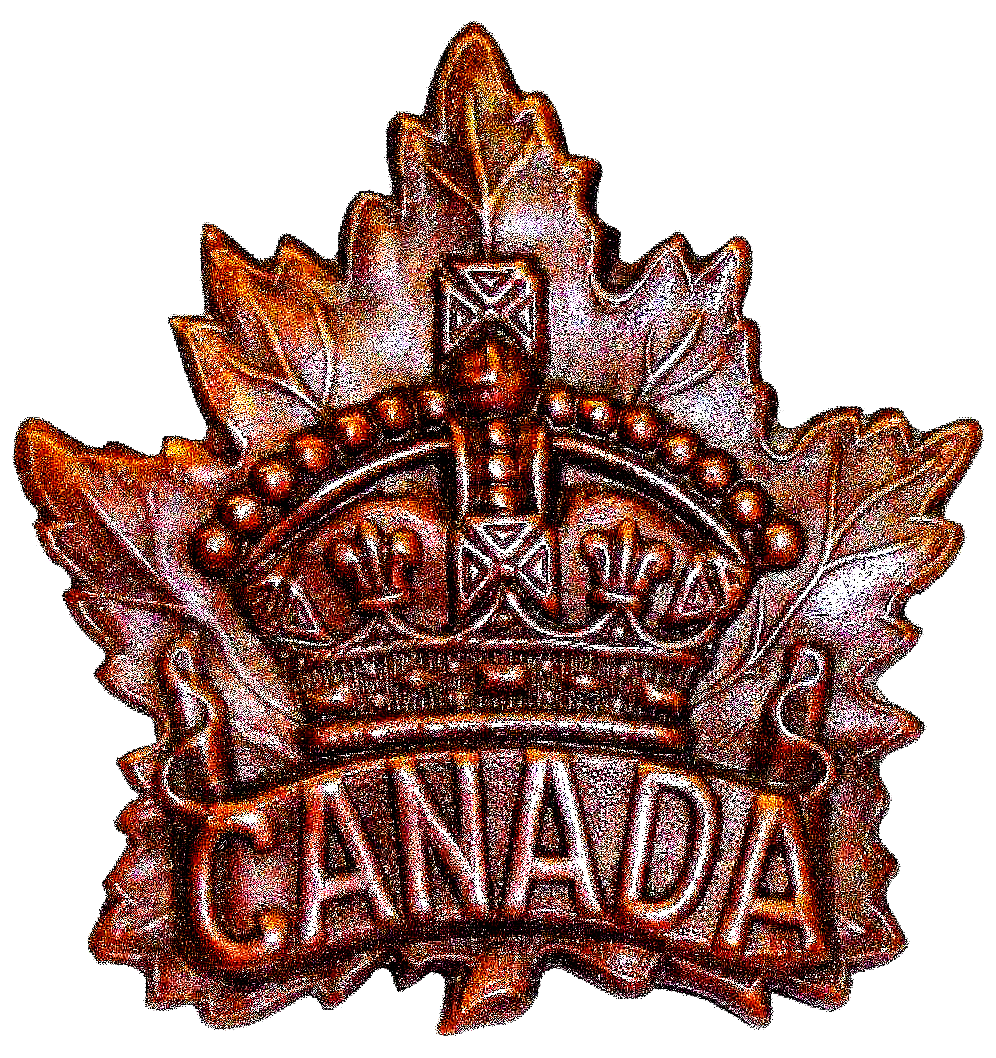
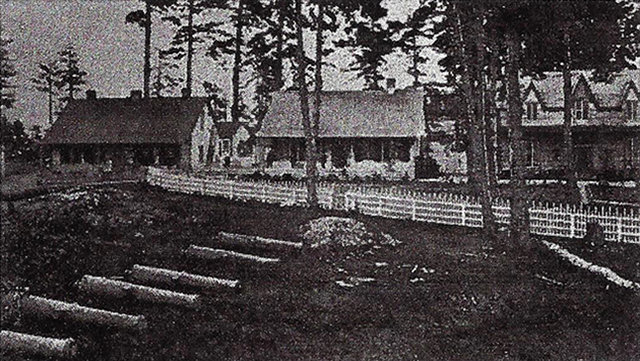
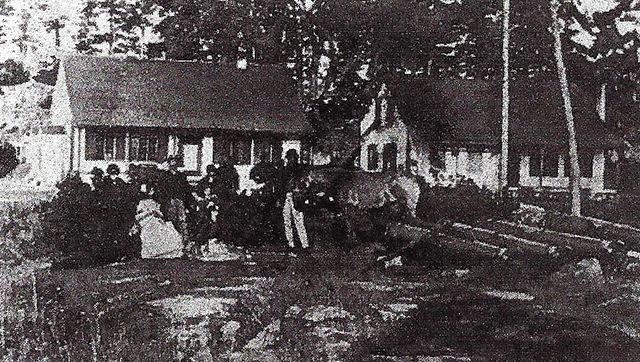
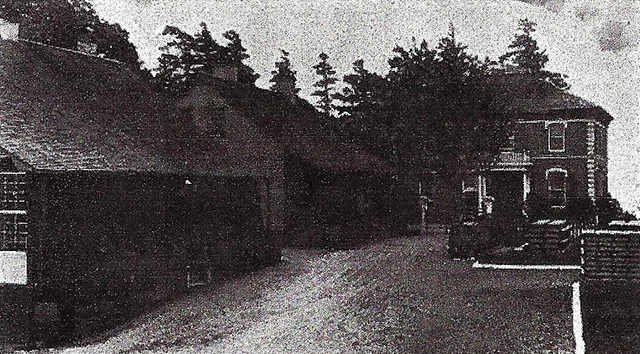
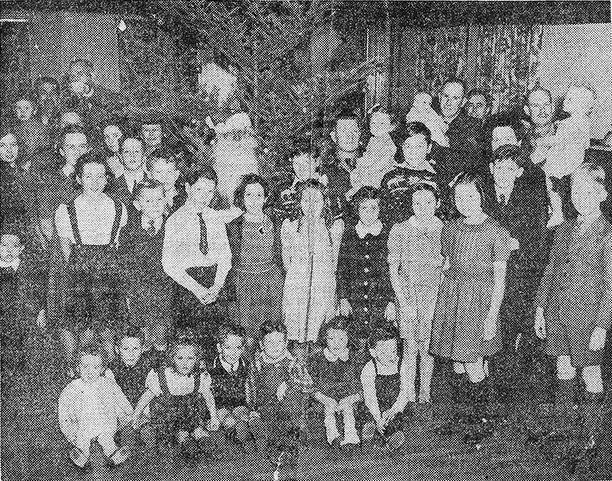
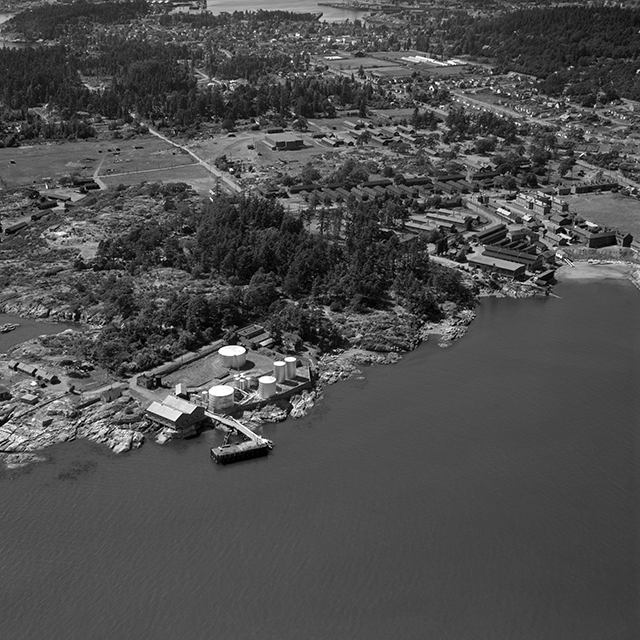
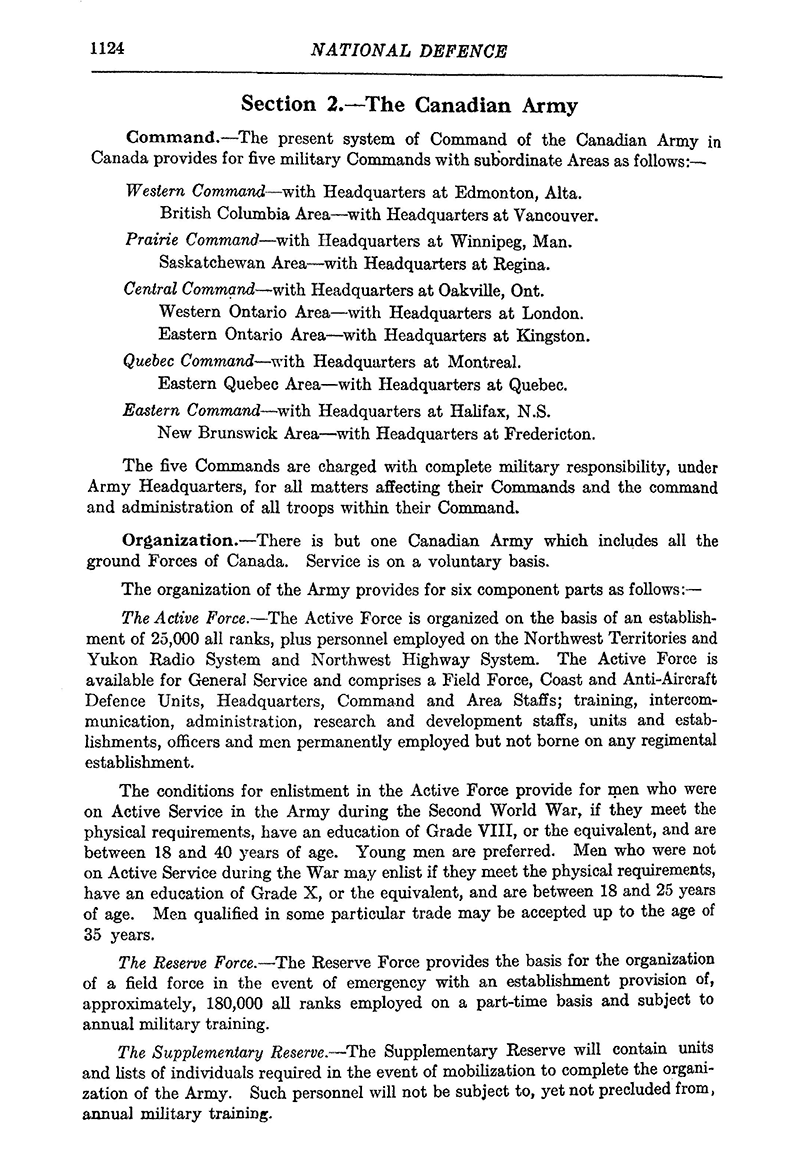
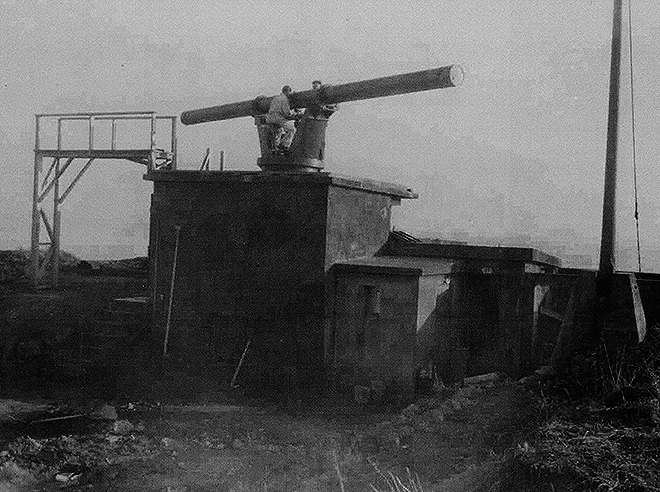

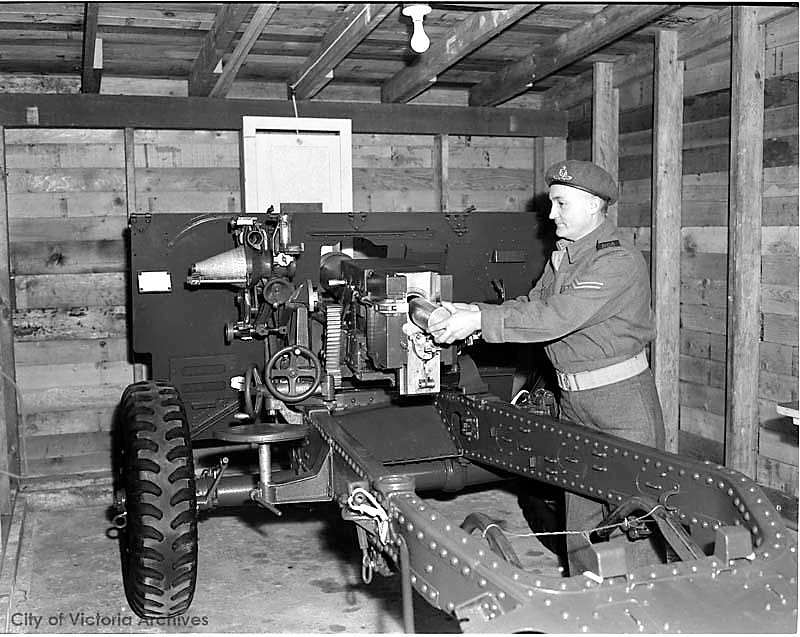
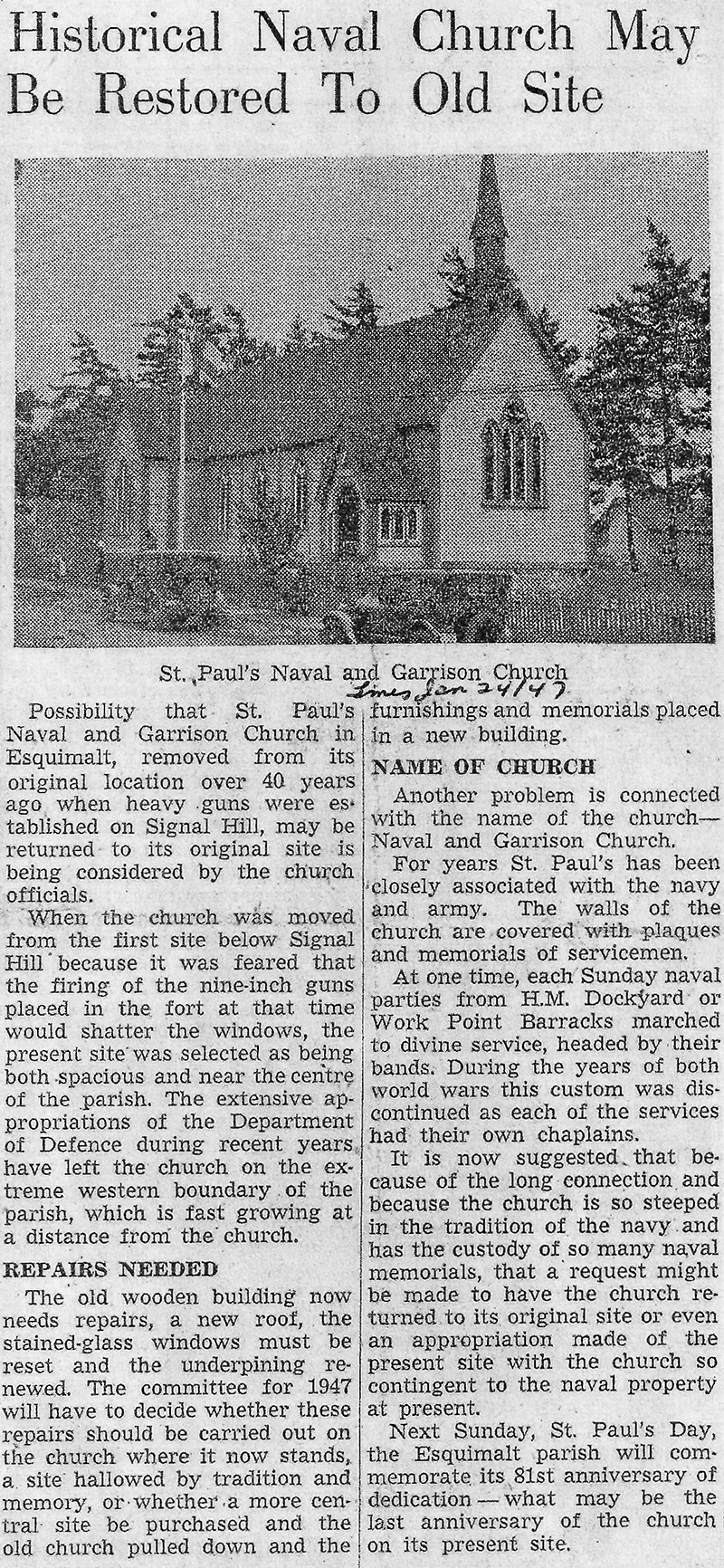
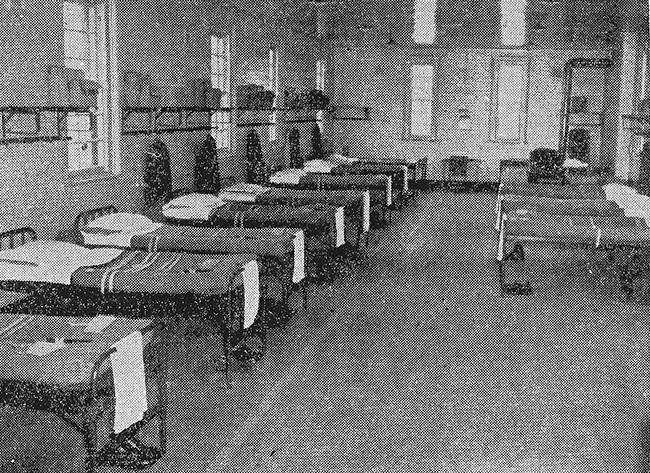
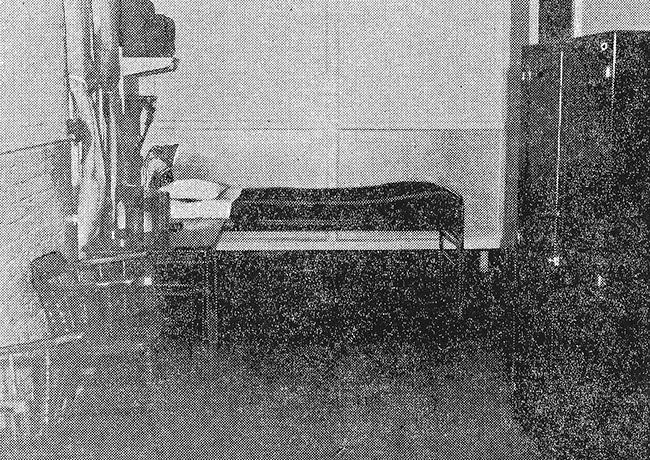
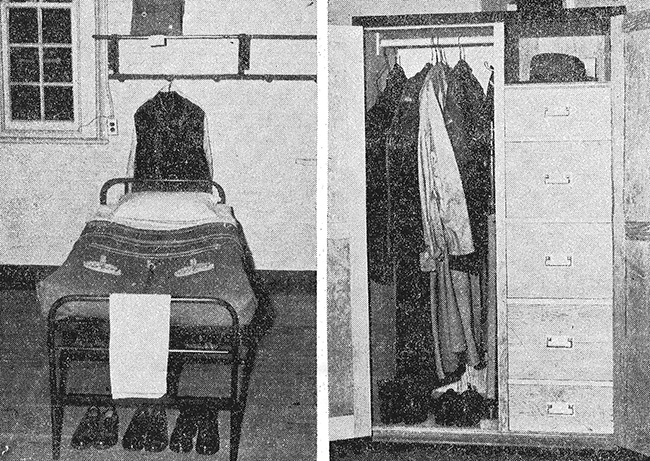




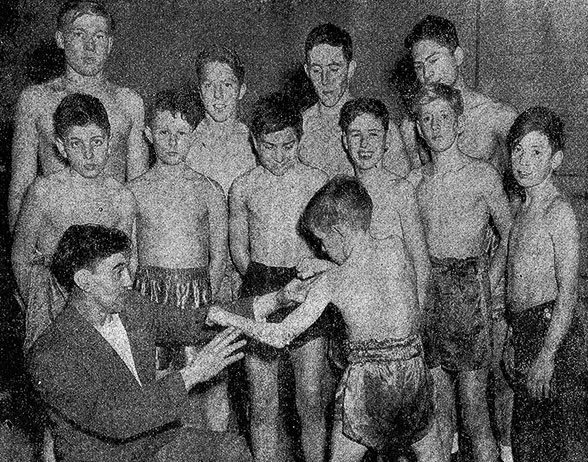
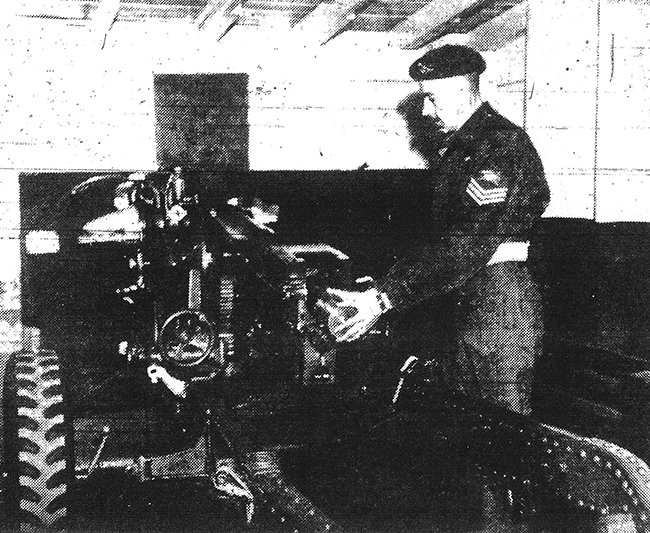
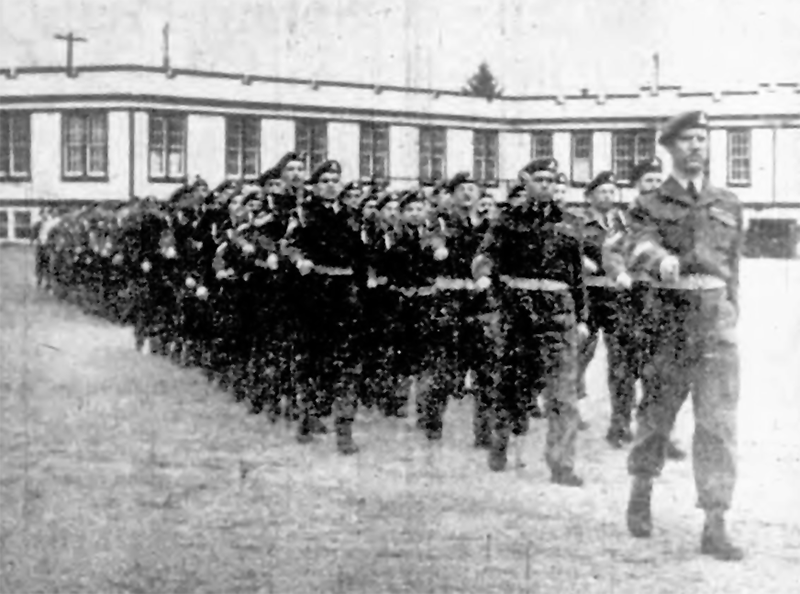
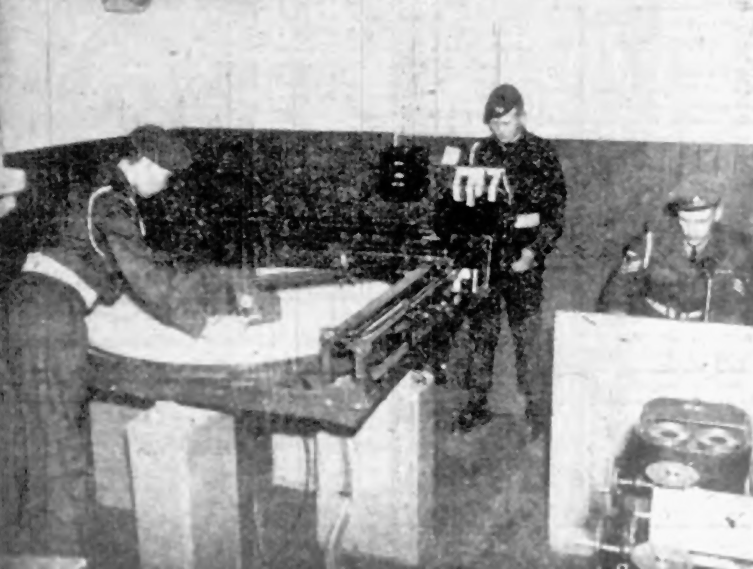
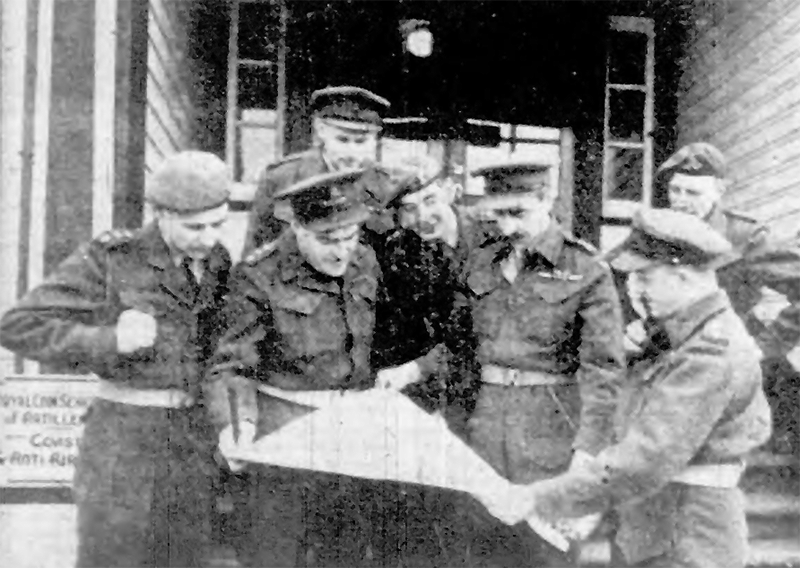
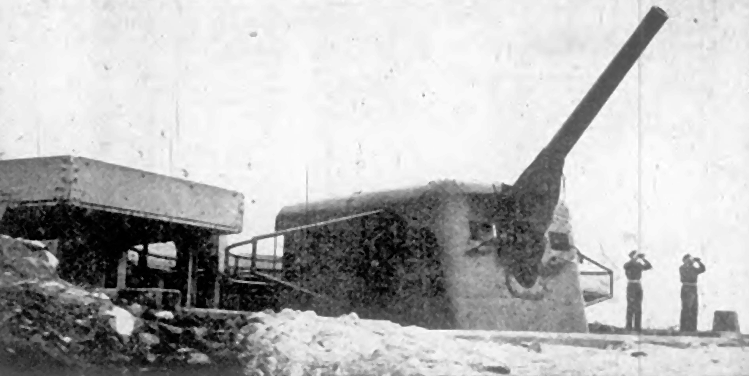
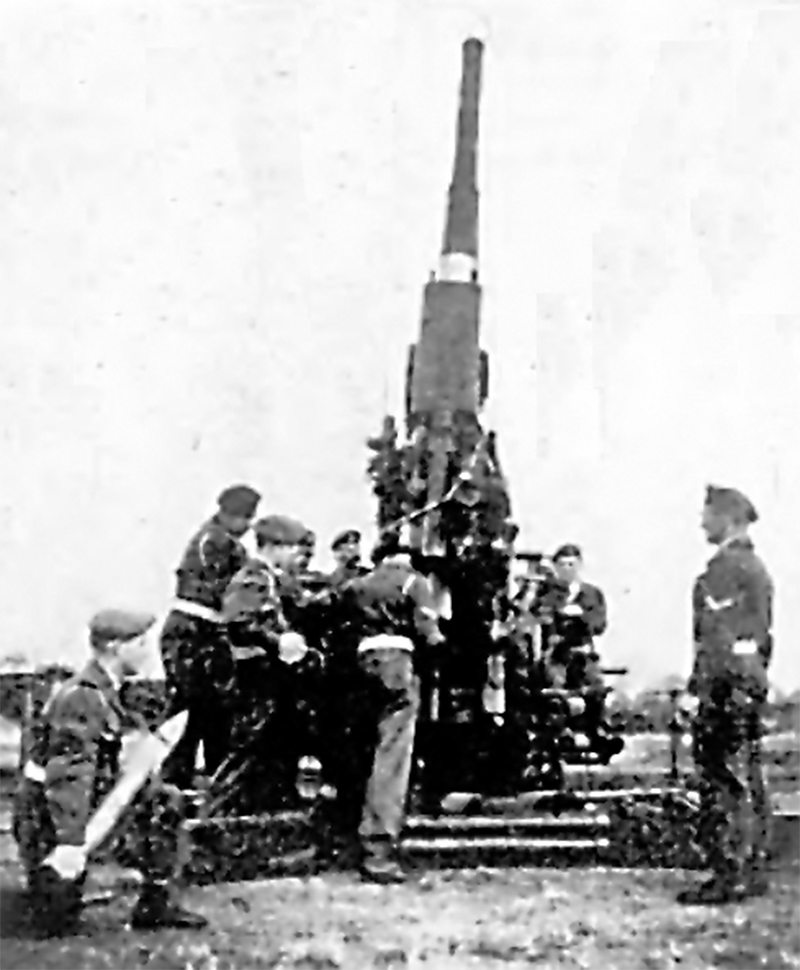
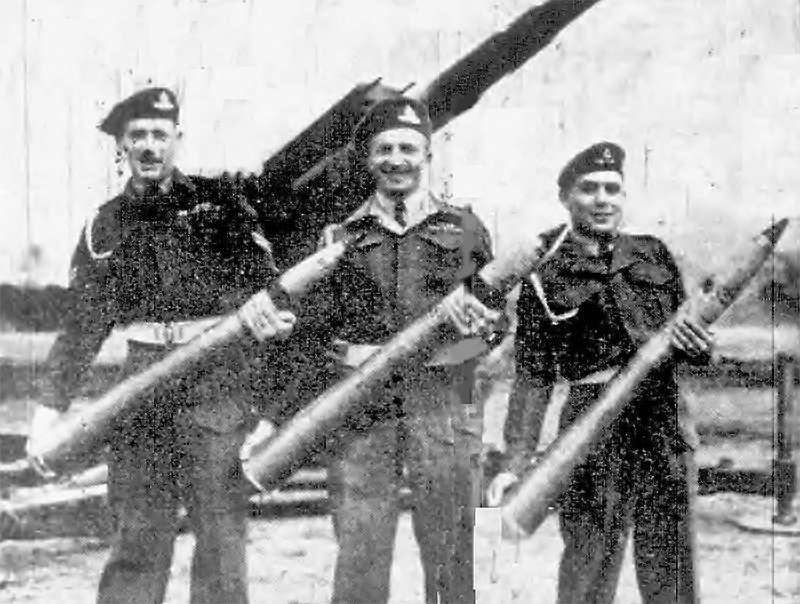
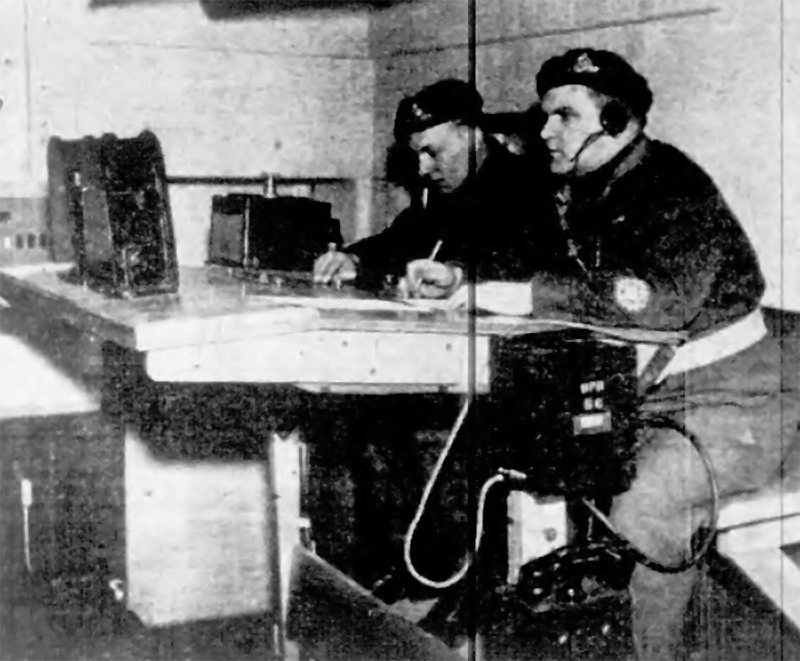
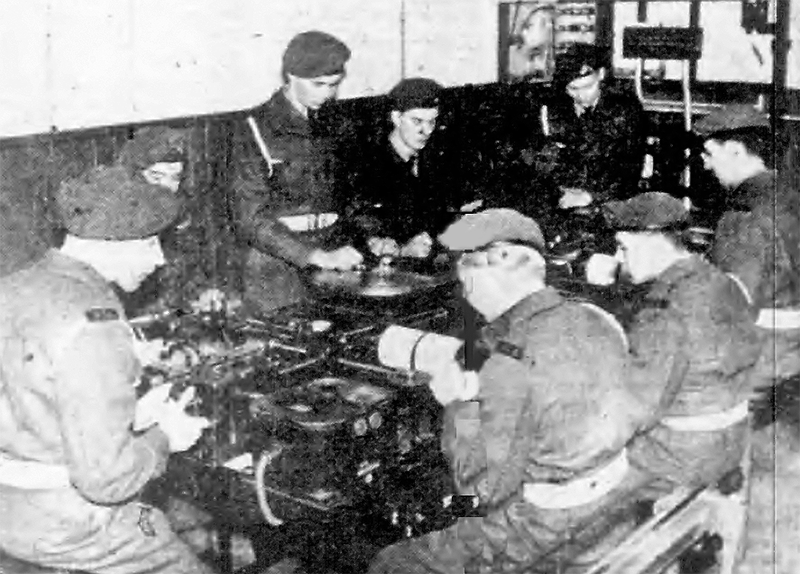
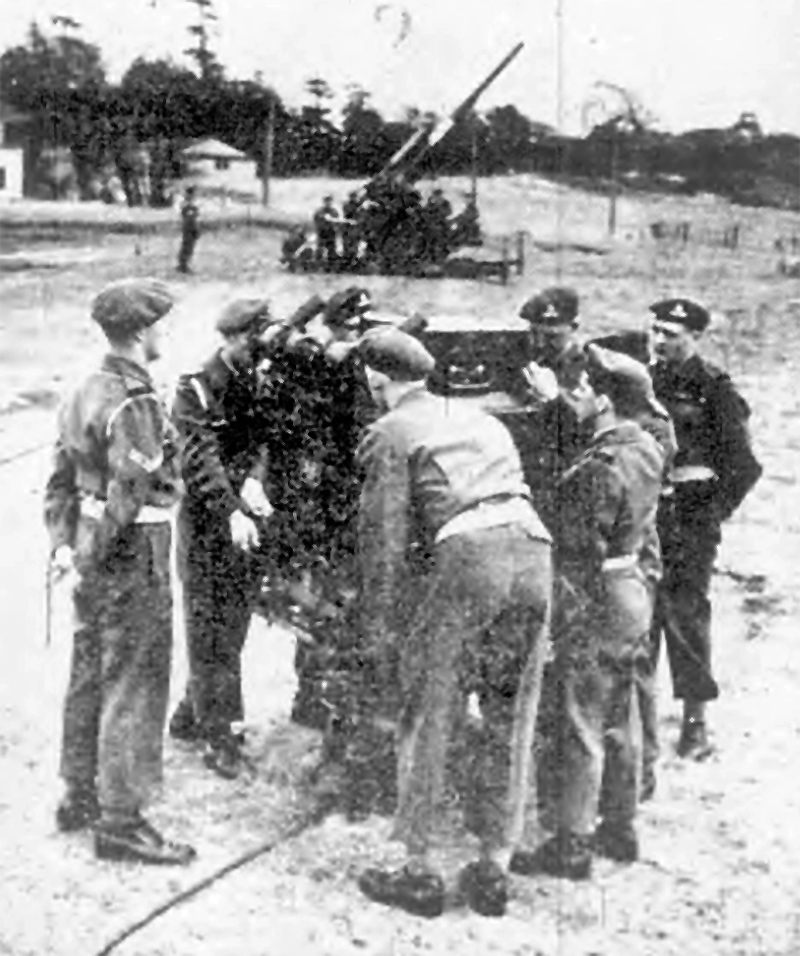
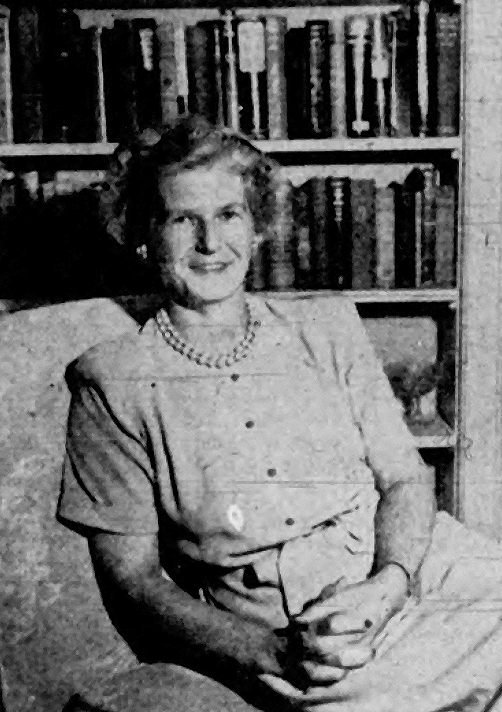
.png)
.png)
.png)
.png)
